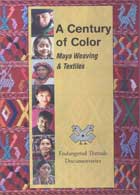
A Century of Color: Maya Weaving and Textiles 2007
Distributed by Endangered Threads Documentaries, 1530 Tuolumne St., Vallejo, CA 94590
Produced by Endangered Threads Documentaries
Directed by Kathleen Mossman Vitale
DVD, color, 53 min.
Jr. High - Adult
Weaving, Textiles, Anthropology, Guatemala, Central American Studies
Date Entered: 05/02/2011
Reviewed by Barbara J. Walter, Longmont Public Library, Longmont, COA Century of Color opens with Gustavus Eisen's 1902 trek into the highlands of Guatemala to study and collect samples of indigenous textiles. Eisen's findings, we learn, formed the basis of the Phoebe Hearst Museum of Anthropology's marvelous collection of Maya clothing and weaving tools. Traveling to the Guatemalan highlands today, what changes might we observe in Maya dress? What forces would we note are driving the change?
One thing that has not changed in over a thousand years is the Maya backstrap loom, unique in its ability to produce textiles with four finished edges. Traditional garments produced on the backstrap loom, such as the huipil (woman's blouse) are introduced; samples from the Eisen collection are shown alongside more recent examples to point up differences in construction and decoration amongst the various highland villages, developments in yarns and dyes, even the influence of tourist trade on design and color choices.
While it is still possible to see Maya women in traditional garb, traje de hombres (traditional menswear) is being abandoned in favor of Western clothing. Civil war (1960-96) and ethnic violence made it dangerous for men seeking work in the cities to wear clothing that identified them as Maya. T-shirts and jeans became an act of self-defense. Increasingly, the traje are worn only during festivals, by older men at home, or by hotel employees. “Paca Americana”—cheap used American clothing shipped in giant containers to Guatemala, sold to distributors by the bale, and found in every village on market day—makes it difficult for a Maya woman to justify the time and expense of clothing herself and her family in handmade garments. Today a Maya girl is apt to be in school, rather than learning weaving at her mother's knee. And she is learning in Spanish, rather than her native dialect, increasing the chances that her taste in dress will be influenced by mass media.
In Manuela and Esperanza we meet two Maya weavers willing to take on the task of completing a traditional huipil in 90 days. The film draws us into the process of choosing the pattern and yarn colors, measuring of the of the warp threads and placement of threads on loom sticks, making the heddle and commencing the weaving process on the backstrap loom. As the huipils take shape, we learn something of the challenges facing their makers—economic difficulties of single motherhood, physical discomforts of pregnancy, looming deadlines for other commissions.
Both films could be used effectively in classrooms to introduce students to the art of Maya weaving, but also to aspects of Guatemalan history, language, culture or current events, including the impact of global trade, mass media, changing roles of women, and civil war on traditional cultures like the Maya.
Narration is clear and insightful throughout, though one could wish for more observations from the Maya themselves on the challenges they face in keeping this art form alive in the 21st century. Appropriate for museum and academic libraries, secondary-level school media centers and public libraries. With English or Spanish narration and subtitles.